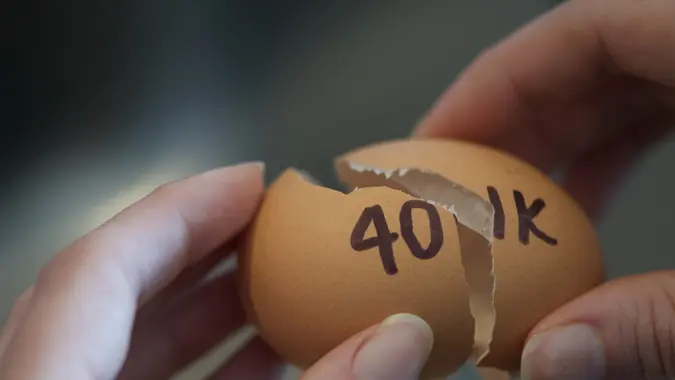How To Protect Your 401(k) From a Stock Market Crash in 2025

Commitment to Our Readers
GOBankingRates' editorial team is committed to bringing you unbiased reviews and information. We use data-driven methodologies to evaluate financial products and services - our reviews and ratings are not influenced by advertisers. You can read more about our editorial guidelines and our products and services review methodology.

20 Years
Helping You Live Richer

Reviewed
by Experts

Trusted by
Millions of Readers
A market downturn can rattle even the most confident investors, especially when your 401(k) balance takes a sudden hit. If you’ve ever wondered how to protect your 401(k) from a stock market crash, you’re not alone. The key is to avoid panic, make strategic moves and remember that market volatility is normal — and often temporary.
Below, we’ll break down how to protect, rebalance and even take advantage of downturns to strengthen your retirement plan for the long run.
Quick Facts: Protecting Your 401(k) in a Down Market
| Key Point | What You Should Know |
|---|---|
| Average 401(k) loss in 2008 crash | Around 25%, according to Fidelity |
| Typical recovery period | 18 to 24 months, for investors who stayed invested |
| 401(k) average balance (2025) | $126,000, Fidelity Q1 2025 data |
| 1 in 4 workers | Miss out on their full employer match, per Vanguard |
| Best way to reduce losses | Diversify and rebalance, not sell in panic |
Understanding Market Crashes and 401(k) Risk
Market crashes happen when multiple factors — from inflation fears to geopolitical events — cause investors to sell off stocks rapidly. During major downturns like the 2008 financial crisis, the average 401(k) lost about 25% of its value, while the 2020 COVID-19 crash saw similar declines, though recovery came within months.
If your 401(k) feels vulnerable, it’s because most plans hold 70% or more in equities, which are most exposed to market swings.
The biggest mistake? Panic selling. Selling after prices drop locks in losses, while those who stayed invested during past bear markets generally recovered their balances within two years.
Tip: Think long-term. Historically, the S&P 500 has delivered an average annual return of about 10%, even after factoring in multiple market crashes.
Step-by-Step Plan to Protect Your 401(k)
Building a resilient retirement portfolio isn’t about timing the market — it’s about preparation and discipline. Here’s how to strengthen your 401(k) before volatility strikes:
- Rebalance regularly: Shift a portion of your investments from high-risk stocks into bonds, TIPS (Treasury Inflation-Protected Securities) or cash equivalents.
- Use target-date funds: These funds automatically become more conservative as you near retirement, removing emotional decision-making.
- Set guardrails: Create rules like “reduce equity exposure by 10% if markets fall 20%.” This helps you act methodically instead of emotionally.
Pro Tip: Vanguard reports that investors who rebalance at least once per year see 20% less volatility in their retirement portfolios over time.
If You’re Approaching Retirement (Ages 50-65)
The years before retirement are crucial because losses now can take longer to recover.
- Build a cash cushion or bond ladder. Keep 2 to 5 years of expenses in low-risk assets so you can avoid selling stocks during downturns.
- Gradually reduce stock exposure. Move from 80% equities to 60% over a few years instead of all at once.
- Consider Roth conversions. When markets dip, convert part of your 401(k) to a Roth IRA. You’ll pay taxes on a lower balance, and future growth will be tax-free.
- Delay retirement if possible. Working even one extra year can boost your retirement security by over 9%, according to EBRI.
For Retirees: 401(k) Protection Strategies That Work
Once you’re retired, your focus shifts from saving to preserving and withdrawing wisely. The bucket strategy is one of the most effective ways to manage risk.
How the Bucket Strategy Works
- Bucket 1: 1 to 2 years of expenses in cash or short-term bonds
- Bucket 2: 3 to 7 years of moderate-risk investments (balanced funds, dividend ETFs)
- Bucket 3: Long-term growth assets (equities, real estate funds)
In a downturn, draw from bucket one while buckets two and three recover. This helps you avoid selling stocks at a loss.
Also, diversify income beyond your 401(k):
- Social Security (start later for up to 8% higher benefits per year delayed until 70)
- Annuities for guaranteed income
- Rental income or part-time work
Should You Move Your 401(k) to Cash During a Crash?
Tempting, but risky. Going all cash can protect you short-term — but it’s a long-term setback. Cash doesn’t keep up with inflation, and you could miss sharp rebounds that often start within weeks of market bottoms.
Instead, consider stable value funds within your 401(k). They offer principal protection while earning slightly higher returns than cash.
Short-term Treasuries or CDs can also work as temporary safe havens with modest yields.
Defensive Investments for Volatile Markets
When turbulence hits, focus on balance — not complete safety.
Here are reliable options to steady your 401(k):
| Investment Type | Benefit | Typical Use |
|---|---|---|
| Government Bonds/TIPS | Hedge against inflation and volatility | 30 to 40% of the portfolio for pre-retirees |
| Dividend Stocks/ETFs | Generate income even when prices fall | Ideal for long-term investors |
| Stable Value Funds | Preserve principal, moderate returns | Useful for retirees drawing income |
| Bond Laddering | Steady income through staggered maturities | Helps manage rate risk |
Tax-Efficient Moves in a Down Market
Market crashes can actually be tax planning opportunities.
- Roth Conversions: Convert while account values are lower to pay less in taxes now.
- Tax-Loss Harvesting: Sell losing investments in taxable accounts to offset gains elsewhere.
- RMD Planning: If you’re over 73, plan your required minimum distributions carefully. During strong market years, take extra withdrawals to reduce pressure later.
Stat to Know: Fidelity estimates that strategic Roth conversions can save retirees up to $20,000 in lifetime taxes.
Common Mistakes to Avoid During Market Crashes
Even seasoned investors make emotional mistakes when markets fall. Avoid these pitfalls:
- Panic selling: This locks in losses and eliminates the chance to recover.
- Overcorrecting your allocation: Shifting too heavily into cash or bonds limits growth.
- Borrowing from your 401(k): You’ll owe taxes, lose compounding growth and repay with after-tax money.
- Ignoring your long-term plan: History shows every U.S. market downturn — from 1929 to 2020 — eventually recovered.
How to Stress-Test Your 401(k)
Think of stress testing as a financial fire drill. It helps you see how your portfolio would perform in extreme scenarios.
- Use retirement calculators (like GoBankingRates’ retirement calculator) to run Monte Carlo simulations.
- Model a 30% or 50% drop and a multi-year recovery.
- Adjust assumptions for inflation, longevity and expected returns.
Vanguard’s research shows that portfolios tested under multiple stress conditions have 25% higher success rates than those built on optimistic assumptions.
When to Talk to a Fiduciary Advisor
If you’re within five years of retirement or have lost more than 20% of your portfolio, now’s the time to get professional advice.
A fiduciary financial advisor can help you:
- Build a sustainable withdrawal strategy
- Optimize taxes on Roth conversions and RMDs
- Balance growth vs. safety based on your timeline
Think of this as an investment in peace of mind — not just your portfolio.
Final Take to GO: Stay the Course — and Keep Your 401(k) on Track
Market crashes are unsettling, but they’re also inevitable — and temporary. What matters most isn’t avoiding every dip, but staying disciplined through them. By rebalancing regularly, diversifying your holdings, and avoiding panic-driven decisions, you protect the foundation you’ve built over decades of saving.
Your 401(k) is designed for the long haul. Even after major downturns like 2008 and 2020, long-term investors who stayed the course fully recovered — often within just two years.
If you’re unsure how to adjust your mix of stocks and bonds or when to rebalance, use a retirement calculator or speak with a fiduciary financial advisor to fine-tune your plan.
The market will always fluctuate — but your future doesn’t have to. Stay calm, stay consistent and let time do the heavy lifting for your 401(k).
Protecting Your 401(k) from a Stock Market Crash FAQ
Here are the answers to some of the most frequently asked questions about stock market crashes and how to protect your 401(k) in the event it does happen.- Should I move my 401(k) to bonds before a crash?
- Shifting some funds into bonds can reduce volatility, but avoid overdoing it. You still need growth to outpace inflation.
- How much should I keep in cash?
- Aim for 1–2 years of living expenses in cash or short-term bonds if you’re near retirement.
- What happens if I panic sell during a crash?
- You’ll lock in losses. Staying invested historically leads to full recovery within a few years.
- Can I retire during a market downturn?
- You can, but it’s safer to delay a year or reduce withdrawals temporarily.
- What’s the best long-term strategy to protect my 401(k)?
- Diversify, rebalance annually, avoid emotional decisions and work with a fiduciary if you’re nearing retirement.
Information is accurate as of Oct. 28, 2025.
Our in-house research team and on-site financial experts work together to create content that’s accurate, impartial, and up to date. We fact-check every single statistic, quote and fact using trusted primary resources to make sure the information we provide is correct. You can learn more about GOBankingRates’ processes and standards in our editorial policy.
- Vanguard "Stress testing"
- Vanguard "IRA Roth conversion"
- Morningstar "Why Cash Is Still King for Short-Term Goals"
- U.S. Social Security Administration "Retirement Benefits"
- Employee Benefits Research Center "2025 EBRI/Greenwald Retirement Confidence Survey"
- Vanguard "Portfolio rebalancing: Navigating volatility in Vanguard Target Retirement Funds"
- Merrill Lynch "7 tips for dealing with a prolonged market downturn"
- Experian "What Is the Average Stock Market Return?"
- Fidelity "3 reasons your portfolio may be underperforming"
 Written by
Written by  Edited by
Edited by 

























